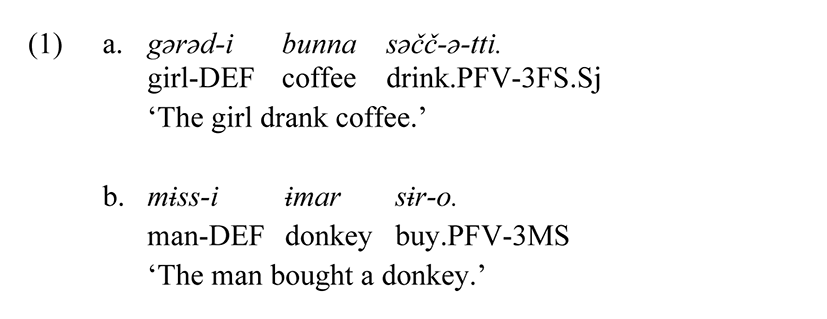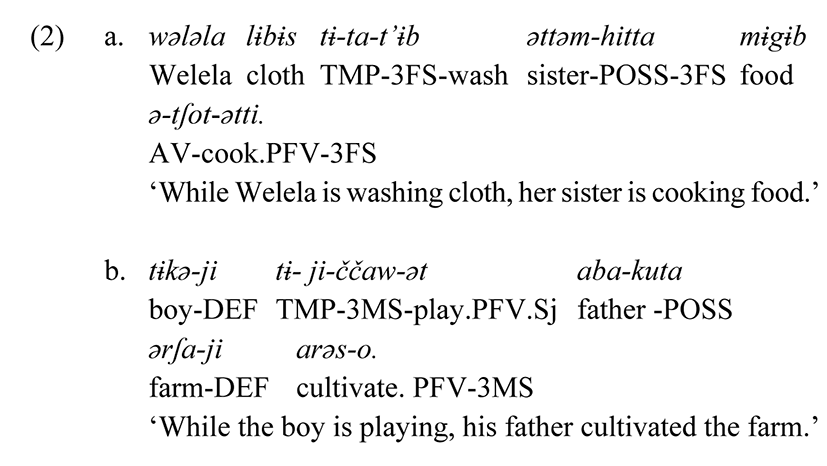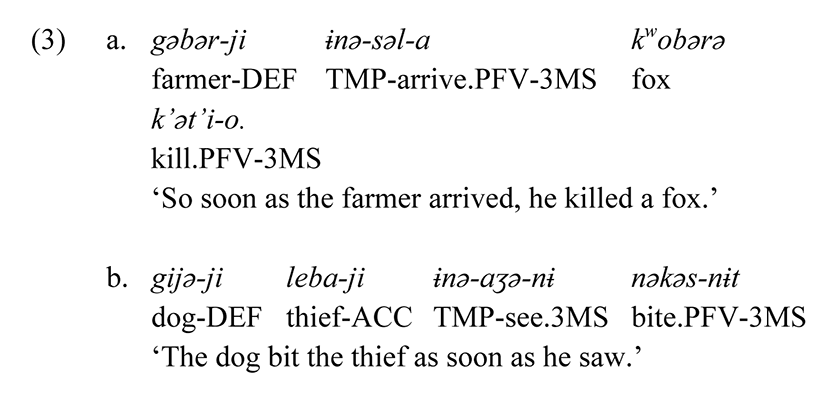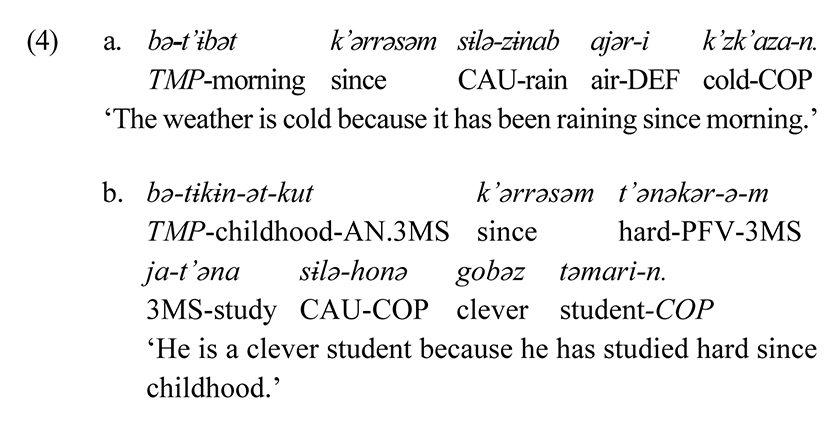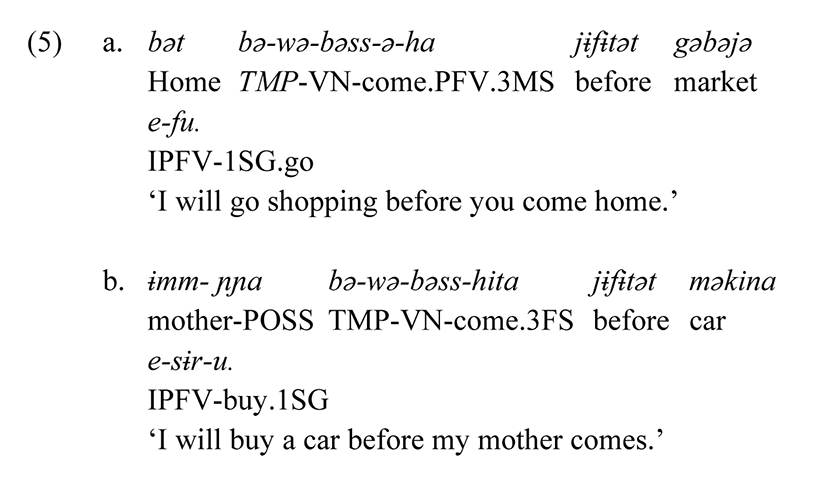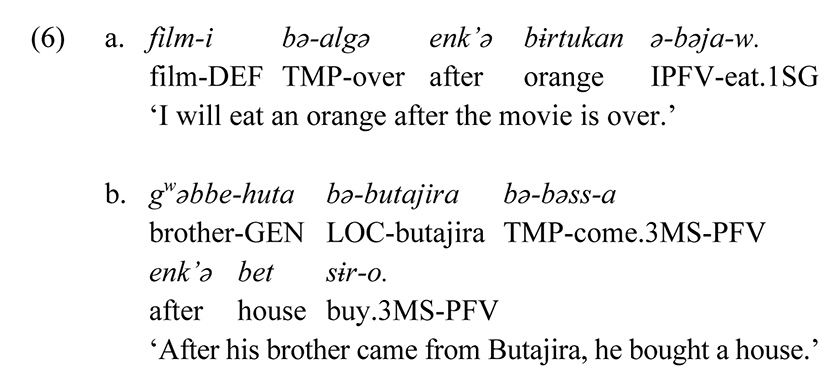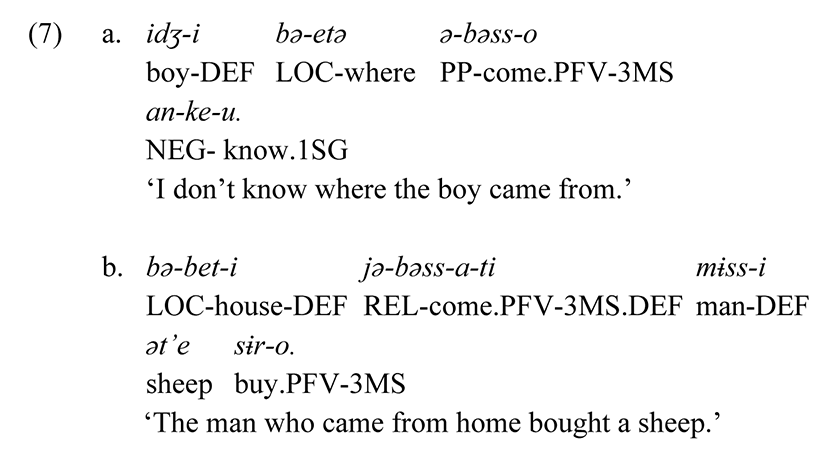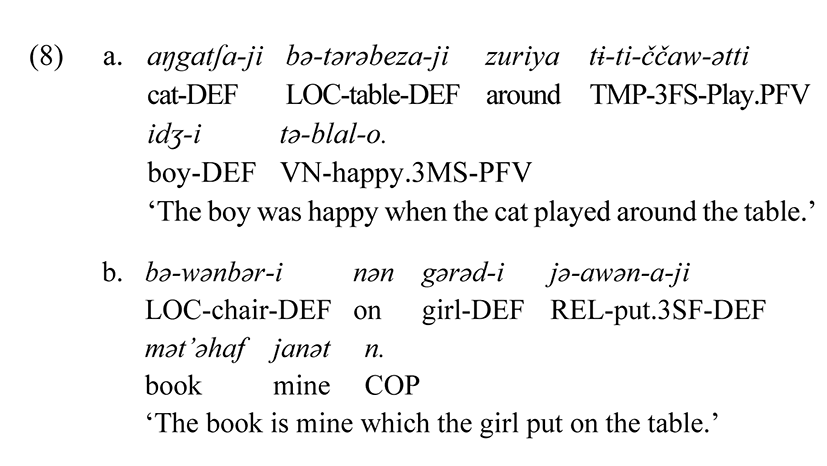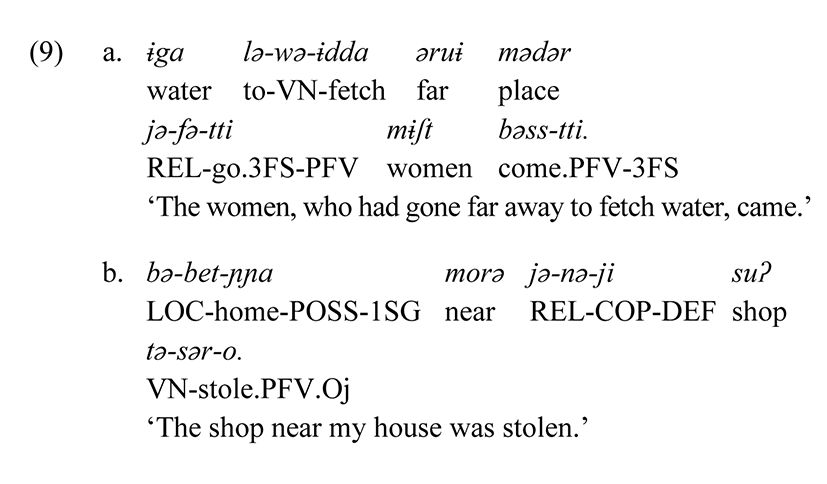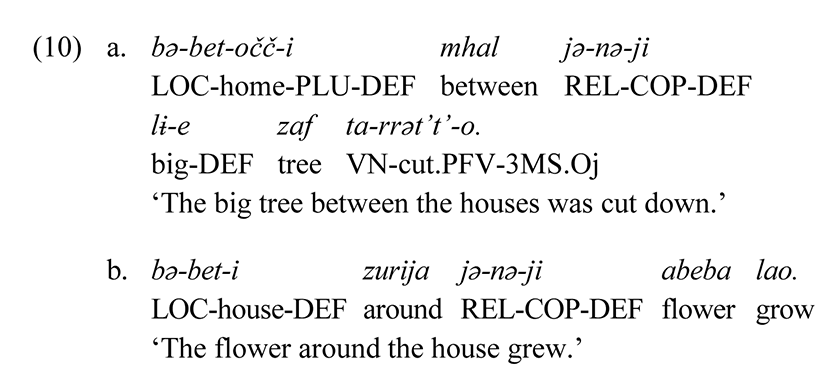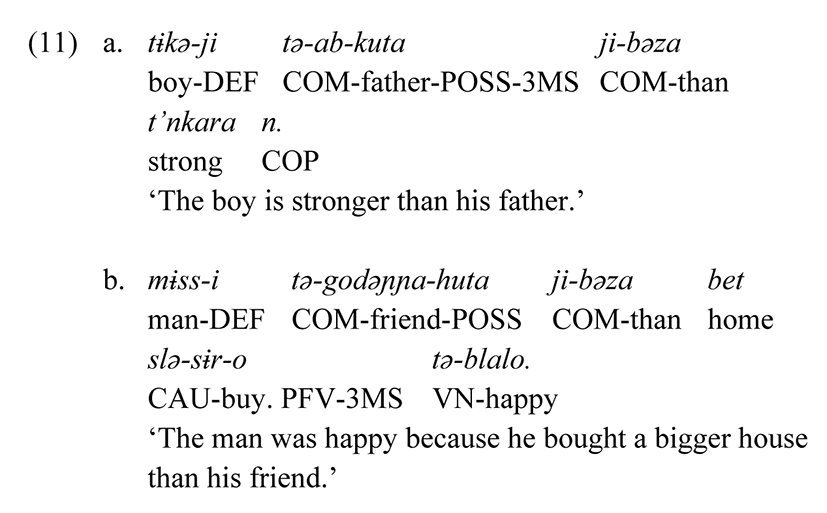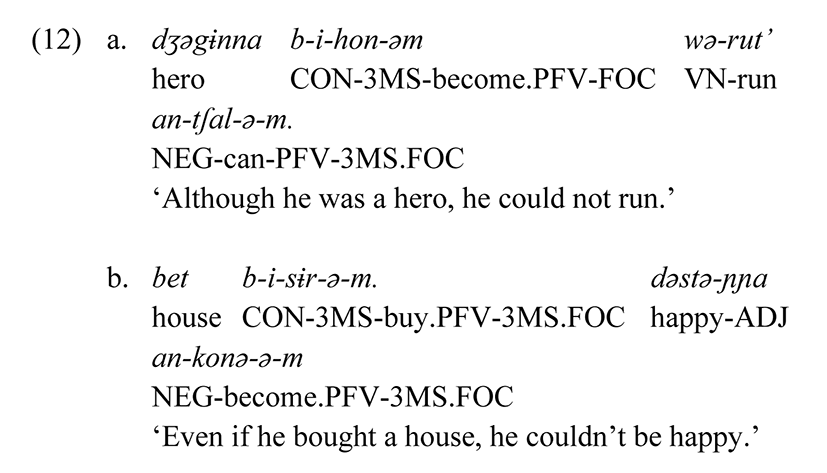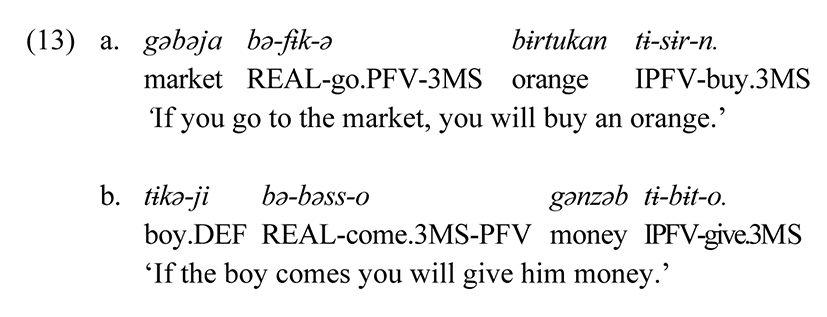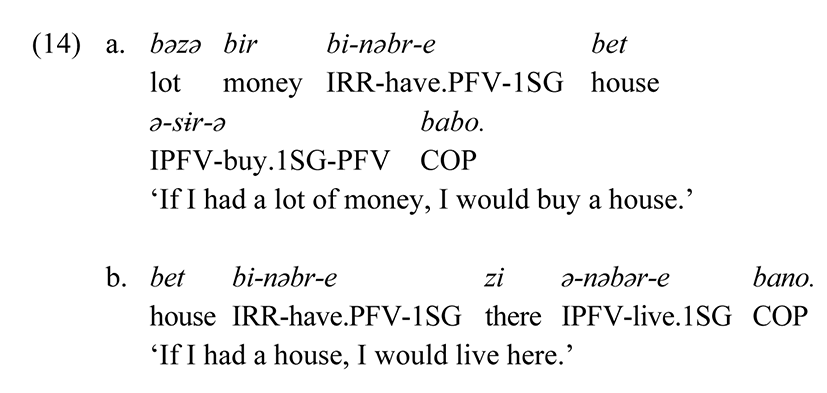1. Introduction
The Gurage language is one of the most widely spoken languages in Ethiopia and belongs to the Semitic branch of the Afroasiatic language family. The Afroasiatic language family includes well-known languages such as Arabic and Amharic, which are spoken in much of Africa and the Middle East (Goldenberg 1968).
In Ethiopia, the Gurage ethnic group mostly lives in the southern region of the Gurage zone and its surroundings, and they speak the Gurage language. The ethnic groups of Gurage have their language, tradition, and culture. These languages are grouped under the East, West, and North Gurage categories. Gurage languages can be a bit difficult to classify due to their close relationship and similar linguistic features (Hetzron 1977). Many scholars have classified the Gurage languages in different ways, but the researchers prefer to present classification (Hetzron 1977).
Despite being classified as Semitic, the Gurage languages also display distinctive linguistic traits that set them apart from other Semitic languages spoken in the area. Linguists classify the Gurage languages as belonging to the Semitic branch within the Afroasiatic family based on linguistic features, shared vocabulary, and historical connections between these languages (Feleke 2021). Significant linguistic variation may be seen in the Gurage languages themselves, with numerous dialects being used by diverse Gurage populations. While there is some mutual understanding among these kinds, they might also have unique characteristics that make them stand out (Hetzron 1977).
The primary concentration of this investigation lies within Dobbi, a language that falls under the northern subgroup of Gurage languages, which is known to be one of the most under-researched languages within this particular grouping. The society that speaks this language resides close to Muhr, Kistani, and Mesqan speakers in the southwest, southeast, and southwest respectively. Consequently, some Dobbi speakers also possess proficiency in one of these languages as a secondary language (Kebede 2002). According to Teshome (2016: 6), the region is divided into three primary areas: Dega Goot (a highland region), Dobbi (a temporal or sub-tropical region), and Welensho Andegna and Welansho Huletegna (a lowland region). In earlier studies, the language was referred to as Goggot, Dobbia, and Guragenna. However, in more recent research investigations, both the language and the society are referred to as Dobbi (Teshome 2016: 5).
The Gurage people have traditionally been predominantly engaged in the field of agriculture, with a focus on crop cultivation. The primary sustenance produced by this community is referred to as Enset, which is commonly known as the “false banana”. The majority of the Gurage population consists of individuals who primarily cultivate vegetables, legumes, and Enset. Enset serves as their primary source of income, although they also engage in the cultivation of coffee and various other green plants, as well as the cultivation of other crops. Furthermore, the Gurage people partake in animal husbandry, raising livestock such as cows, horses, mules, sheep, and goats (Fekadu 2014). According to Kebede (2002), the population is estimated to be 15,000, whereas Meyer (2005) approximates that there are around 4,000 individuals who speak Dobbi.
2. Objectives and Methodology
The main objective of this investigation is to explicate the construction of adverbial clauses in Dobbi. The research design adopted in this study is descriptive and employs a qualitative methodology. To ensure a comprehensive and robust dataset for analysis, two separate fieldwork periods were conducted in the city of Butajira. The overall time required to complete these aforementioned research excursions amounted to one and a half months. To establish a substantial database, data gathering techniques such as elicitation were employed. Throughout the fieldwork, the primary language of communication was Amharic. A linguistic questionnaire, written in Amharic, served as a crucial instrument for data collection. The descriptive approach was utilized to systematize and scrutinize the gathered data. To present the findings, a three-line interlinear morpheme-by-morpheme format was employed. In this format, the first line corresponds to the informant’s actual speech, the second line consists of a hypothetical morpheme that provides glossing, and the third line supplies an English literal translation.
3. Adverbial Clause
The adverbial clause is among the three primary classifications of subordinate clauses, alongside the relative and complement clauses. These clauses rely on another clause, specifically the main clause, for their existence. Their grammatical purpose is to function as an adverbial, delivering details on the temporal, locative, causal, conditional, or other circumstances associated with the situation depicted in the main clause (Kortmann 1998).
An adverbial clause, which frequently addresses inquiries regarding the time, location, reason, manner, or degree of an action, can be introduced by subordinating conjunctions such as “when”, “while”, “where”, “because”, “although”, “since”, “if”, and other similar conjunctions (Crystal 1992: 9). One of the most essential components in constructing an adverbial clause is the subordinate conjunction. This word or morpheme serves as the introductory element of the adverbial clause, establishing the connection between the adverbial clause and the main clause (Thompson et al. 2007).
Diessel (2001) states that the placement of the adverbial clause depends on the language’s word order. Postposions are used when the grammatical structure of the language is subject-verb-object (SVO1) and proposed adverbial clause construction is used when the grammatical pattern is subject-object-verb (SOV). In different languages, adverbial clauses may appear at the beginning, as in English; at the end, as in Kombai (an Indonesian language of Trans-New Guinea); or within the clause (between the subject and the verb), as in the Bantu language in Uganda (Dryer 2011).
Adverbial clauses serve as adjuncts that function as modifiers of the verb in the main clause and can be readily distinguished due to their introduction by subordinating conjunctions. These clauses can be interpreted as inquiries, as the semantic meaning of the adverbials varies depending on the specific words utilized within the clause. To illustrate, a temporal time adverbial addresses the question “When/for how long until?”, a locative adverbial addresses the question of where, and a manner adverbial addresses the question of how the roles of the adverbials in the sentence are delineated. Conversely, adverbials can adopt various syntactic forms; they may consist of single words, prepositional phrases, noun phrases or even entire clauses (Fischer 2007: 317).
4. Description of an Adverbial Clause in Dobbi
Dobbi follows the SOV word order in the conventional sense. This word order is also observed in other languages such as Ezha, Wolane, Mesqan, and more, which are part of the Gurage language family. For instance, Endalew (2014) has discussed the SOV word order in Ezha, Meyer (2006) has examined the same in Wolane, Meseret (2012) has explored the Mesqan language, and Zeleke & Asfawwesen (2022) has also stated that South Ethio Semitic Languages have SOV word order. These languages, including Dobbi, exhibit the same characteristic of placing the subject before the object and then the verb. To further illustrate this, let us analyze a few examples from the Dobbi language:
A declarative sentence observed in (1a) gərədi bunna səččətti denotes ‘The girl drank coffee.’ The subject gərəd ‘girl’ in the structures implies a common noun, followed by the object noun bunna, which means ‘coffee’ and the verb səčč ‘drink’ appears at the end of the given sentence. There are also declarative statements in (1b) mɨssi ɨmar sɨro ‘The man bought a donkey.’ The constructions use the word mɨss ‘man’ as the subject, ɨmar as the object represented by ‘donkey’, and sɨr ‘buy’ is the verb placed at the end of the sentence. As a result, as shown by the construction described above, the language employs SOV order construction.
Types of adverbial clauses reported for languages around the world can be divided into twelve basic types, which are: (i) Clauses substitutable for by a single word: time, location, manner; (ii) Clauses not substitutable for by a single word: purpose, concessive, reason, substitutive circumstantial, additive, simultaneous, absolutive, and conditional (Thompson et al. 2007). Some of these adverbial types in Dobbi will be described in the following section.
A temporal clause is a kind of adverbial clause that links an event in that clause to another event in the main clause in a time relationship. This clause provides answer to the question ‘when’ and specifies the moment at which something occurred or will occur. A subordinating conjunction used to combine the dependent clause and the main clause is when, while, as soon as, after, before, and until (Bagari 1976).
According to Crystal (1992: 9), time clauses serve as the temporal link between the main and subordinate sentences, indicating the occurrence of an action. Consequently, the action may transpire concurrently, earlier or later, since, until, and so forth. Additionally, the temporal clause specifies the commencement and conclusion of an event, as well as the specific moment and duration of time, whether momentary or repetitive. In Dobbi, a temporal clause consists of an independent clause and a dependent clause, connected through temporal connectors. These subordinators pertain to a particular time frame. Dobbi uses the morpheme tɨ- to denote simultaneous action in a temporal phrase. Let us see the following constructions in Dobbi:
In Dobbi, simultaneous action can be represented by prefixing the morpheme tɨ- to the verb root. As observed in (2a) and (2b), the dependent clauses come at the beginning of the sentence and the element tɨ- prefixed to the verb indicates that there is an unfinished simultaneous action that requires an independent clause. In (2a), the verb t’ɨb ‘wash’ has prefixed the simultaneous action marker and the agreement marker tɨ-, ta- ‘while’ and ‘3FS’ respectively. Therefore, the prefix tɨ- is a time indicator, that prefixes the verb and shows that the activity was performed at the same time. It demonstrates that the action specified in the main clause is at the same time as the dependent clause. In (2b), the verb appended the time marker tɨ- which refers to the action of the dependent clause that occurred at a comparable time with the action of the independent clause.
Dobbi, on the other hand, uses temporal sentences to show the sequence of two activities by employing the dependent morpheme ɨnə- ‘as soon as’. This morpheme combines the two clauses into one and indicates which action is performed first in the action sequence.
Let us consider the following constructions:
As we can see from structure (3a), the sentence contains two verbs, one in the main clause and the other in the subordinate clause. The main verb is placed in the independent clause which expresses the action performed by the subject. The dependent clause is found at the beginning of the sentence. In this clause, the definiteness marker -ji is suffixed to the head noun gəbər ‘farmer’ and the subordinator ɨnə- ‘as soon as’ is prefixed to the verb səl ‘arrive’. The adverbial clause gəbərji ɨnəsəlo ‘as soon as the farmer arrives’ expresses the first action and it requires the second action kwobərə k’ət’əjo ‘he killed a fox’. The second action happens immediately after the first action is done. In the main clause, the verb suffixed to the agreement marker -o refers to ‘PFV-3MS’. The subordinating conjunction ɨnə- describes the time that indicates that two actions are performed in succession. In structure (3b), the subordinator ɨnə- ‘immediately’ indicates that two actions occurred in quick succession. The first and second steps indicate that they happened within a certain time interval. It clearly shows that it took place sometime apart in the two texts. On the other hand, Dobbi allows for the expression of the temporal clause using free lexical morphemes such as jɨfɨtət ‘before’, enk’ə ‘after’, zanɨn ‘until’, and k’ərrəsəm ‘since’.
The term k’ərrəsəm ‘since’ denotes the moment at which a particular action commences. This linguistic expression serves as a bridge between two distinct clauses, yet it does not manifest itself in the initial position of the Dobbi sentence structure. The subordinating conjunction k’ərrəsəm ‘since’ is strategically positioned within the confines of the embedded clause, specifically in the middle.
Let’s take a look at the example below:
In structure (4a), bət’ɨbət k’ərsəm sɨləzɨnab denotes ‘because it has been raining since morning’. It is a time clause placed at the beginning of the sentence and the temporal marker bə- is prefixed to the word t’ɨbət ‘morning’. The subordinating conjunction k’ərrəsəm ‘since’ is a conjunction that describes the time at which the action takes place or will take place. The structure of the combination of these two time indicators conveys a permanent and complete idea. But if the morpheme bə- occurs alone, the structure would not be correct. Therefore, the clause to convey a complete idea, the conjunction k’ərrəsəm needs to be inserted. Similarly, in (4b), the clause bətɨkɨnətkut k’ərrəsəm ‘from childhood’ indicates when the event began to take place. As we can see in this structure, the time marker k’ərrəsəm ‘since’ is a conjunction with the dependent morpheme bə- indicates when the action has begun. Therefore, in Dobbi, the language uses the bound morpheme bə- and the free morpheme k’ərrəsəm ‘since’ to reveal the time when an action began.
Let’s look at another way to indicate the sequence of actions to use free-standing words. These words are jɨfɨtət ‘before’ anteriority, and enk’ə ‘after’ posteriority. In Dobbi, the time expressions jɨfɨtət ‘before’ and enk’ə ‘after’ are essential tools utilized to denote the occurrence of an event or action within the realms of the past, present, or future. These expressions, classified as subordinating conjunctions, possess the ability to introduce a dependent clause, thereby enhancing the syntactic structure of a sentence.
Let us see the following constructions:
The dependent clause bət bəwəbɨsəha jɨfɨtət ‘before you come home’ is an adverbial clause of time that indicates the time. The proposition put forward by this statement posits the notion that the occurrence of the second event transpired in close temporal proximity to the initial event. This particular clause encompasses the temporal marker jɨfɨtət ‘before’, which serves to indicate the time at which the action occurred. Within this clause, the verb bəss ‘come’ precedes the clitic bə- which co-occurs alongside the autonomous subordinator jɨfɨtət ‘before’. The primary clause is positioned subsequent to the embedded clause, with the main verb fu ‘go’ being prefixed by the imperfective marker ‘.-’.
In (5b), the dependent clause in this construction is located at the commencement of the sentence. This clause pertains to the presence of an action that occurs subsequent to the initial action. This is conveyed through the independent morpheme jɨfɨtət ‘before’. The verb bəss ‘come’ in the same clause is accompanied by the prefixed bə- which denotes the temporal aspect. By examining the structure, it becomes evident that the combination of these two temporal markers renders the sentence whole. If one of these two markers is absent, the structure will remain incomplete.
Another method of expressing the time adverb postposed word enk’ə ‘after’, which denotes the presence of an action that occurred before the action in the main clause, is by employing it as a subordinate conjunction in Dobbi. Its principal objective is to establish connections or relationships between different elements, particularly in the context of time and sequence. Specifically, this word serves to indicate the occurrence of an event or action after another event or action. The subordinator enk’ə ‘after’ effectively connects various clauses, thereby facilitating a cohesive and coherent flow of information. Consequently, this conjunction plays a pivotal role in enhancing the overall clarity and comprehensibility of both written and spoken language.
Let us see the following constructions:
The subordinate lexical item enk’ə ‘after’ serves to indicate that the action within the dependent clause takes precedence. In the context of structure (6a), the utilization of the prefixal constituent bə- in isolation, along with the independent subordinator enk’ə ‘after’, when employed in such constructions, yields inadequately constructed entities. Consequently, when the dependent morpheme bə- is employed as a prefix to the verb algə ‘over’, it can also be conjoined with the independent morpheme enk’ə ‘after’ in order to formulate a clause indicative of the temporal aspect. The function of bə- in (6a) is to convey time. The absence of these dependent morphemes within the structure resulted loses in its grammatical integrity.
As we have seen in (6b), the clause gwəbbehuta bəbutajira təbəssa enk’ə ‘After his brother came from butajira’ is an adverbial clause of time and is found at the beginning of the structure. The suffix bə- ‘from’ prefixed to the verb corresponds to the past event, which indicates the time of the action. The word enk’ə ‘after’ connects the two clauses and indicates when the action takes place. We can deduce from the examples above that free morphemes can express time in Dobbi. Furthermore, the verb in the embedded clause was prefixed with the bound morpheme bə- to indicate time. If we remove these dependent morphemes from the structure, the meaning of the sentence yields ungrammatical structure. The subordinator enk’ə ‘after’ links the two clauses and denotes the occurrence of the action.
As we can see from the above construction, the verb that can be identified in the main clause has the ability to denote both the perfective and imperfective aspects. These aspects are linguistic features that pertain to the way in which an action is viewed or perceived in relation to its completion or ongoing nature. The perfective aspect in (6a) typically signifies an action that is completed, while in (6b), the imperfective aspect indicates an action that is ongoing or incomplete. This distinction in verb usage within the main clause allows for a nuanced understanding of the temporal and aspectual qualities of the action being described.
An adverbial clause of place is another subordinate clause that elucidates the location where an event occurred. According to Mensah (2010) cited in Yakub et al. (2021), it is important to note that all bound morphemes are affixes that maintain the class of the root word and do not change its lexical category when attached. In the language of Dobbi, the noun is affixed with the bound morpheme bə- to specify the place where an action transpires. Furthermore, in addition to bound morphemes, Dobbi employs free morphemes such as nən ‘under’, mhal ‘between’, zuriya ‘around’, morə ‘near’, əruɨ ‘far’, and others. These free morphemes divulge the specific location that the verb pertains to.
Let us look at the following examples:
The locative clause pertains to the expressions commonly utilized in response to a ‘where’ question, thereby delivering the fundamental locative function. In structure (7a), the locative marker bə- is prefixed to the word etə ‘where’. This morpheme signifies the specific location from where the boy came from. However, this marker does not possess an independent meaning unless it is attached to the free lexical word etə ‘where’. The collaboration of these free and bound elements renders the structure meaningful. Additionally, Eleshin (2021) noted that interactions between confined and free morphemes are evident. If we were to remove either one of these locative markers, the structure would become ill-formed.
The locative clause, denoted as bəbeti jəbəssati ‘who came from home’, is situated at the onset of the clause, as illustrated in example (7b). The affix bə- that is affixed to the term bet ‘house’ is positioned at the commencement of the clause, with the marker explicitly indicating the location from which the individual arrived.
Dobbi utilizes various forms of locative markers. These markers differ from other temporal signifiers in that they exist independently and possess inherent semantics. Stated differently, they possess the ability to convey meaning without the need for affixation of bound morphemes.
Let us examine the subsequent structures:
In section (8a), the noun tərəbeza meaning ‘table’ is prefixed with the locative marker bə- as well as the independent morpheme zuriya meaning ‘around’, which collectively indicates the specific location where the cat was engaged in play. Consequently, in this particular construction, the independent and bound morphemes converge to convey the spatial context. Nevertheless, it is noteworthy that the bound morpheme can be omitted without significantly impacting the overall meaning of the construction.
The free morpheme nən ‘on’ in (8b) signifies the position of an object and the bound morpheme bə- is an additional prefix-reliant marker of location which denotes the location of the object. The prefix component bə- can be separated from this structure while retaining its intended meaning. Consequently, the self-contained locative marker has the capacity to function as an independent indicator of location.
In addition, the adverbial clause pertaining to location possesses the capability to convey the spatial separation between two specific points. Let us examine the subsequent construction that employs the terms əruɨ ‘far’ and morə ‘near’:
The locative marker that is independent, as demonstrated in (9a), is the term əruɨ ‘far’, which conveys the distance from the site of the activity. In this type of structure, the term that must be modified, mədər ‘place’, is obligatory; however, the exclusion of these adjectives would lead to a grammatical error. In (9b) of this sentence, the term morə ‘near’ pertains to the site of the activity, which follows the relativized verb. Another term that denotes location is the affixed morpheme bə-, which is attached to the term bet ‘house’, but when this affixed morpheme occurs alone, it does not indicate the site of the activity.
Note that the presence of the dependent morpheme, which serves to indicate a specific location within the aforementioned construction, is not obligatory. This implies that, upon its removal from the construction, there is no discernible alteration in meaning.
The alternative indication of location is mhal ‘between’, zurija ‘around’, which signifies the position of the item in relation to another object, signifying the exact location of the action. Let us examine the subsequent constructions:
In structure (10a), the independent locative marker is placed between the noun betočči ‘houses’ and the verb. Additionally, the prefixal locative marker is affixed to the noun ‘bet’ in order to indicate its location. In the case of Dobbi, the dependent locative marker can be omitted without causing any grammatical issues within the language.
In (10b), the dependent clause is constituted by the affixed locative marker bə- to the noun bet ‘house’, while the free morpheme zurija ‘around’ precedes a verb. The verb is affixed with the relativizer marker and suffixed with the agreement marker. As can be observed from the analysis of the structure, the clause consists of two markers denoting position: the first is the initial position of the dependent clause, while the second is the middle position of the dependent clause. Eliminating the element bə- attached to the noun bet ‘house’ does not yield any grammatical errors. The free morpheme encountered in this structure conveys the whereabouts of the action. Consequently, in Dobbi, the bound and free locative markers explicitly expound the location of the verbal action. Nevertheless, when the bound morpheme is omitted, no grammatical errors arise. In conclusion, the adverbial phrase of place pertains to the state of affairs or the location where the object is situated.
Note that in Dobbi, the expression of location can be articulated through the utilization of the element bə-/tə-. In this particular article, the researcher employs the element bə- as a means of signifying the specific place of the object. The Dobbi locative clause consists of either a locative noun, which may have lexical content, or a morpheme that lacks lexical content. In specific constructions, the bound morpheme is used in conjunction to indicate the location of the object; in these instances, the mandatory element cannot be omitted. On the other hand, in other constructions, the free and bound morpheme can indicate the place of the object, allowing for the removal of the dependent element without affecting the grammatical structure.
In Dobbi, the adverbial clause of comparison serves to elucidate the manner in which the subject of the dependent clause is compared with the subject of the main clause. The linguistic system of this language employs two distinct modes of comparison, specifically those pertaining to degree and manner.
Let us see the following constructions:
The adverbial clause of comparison is employed for the purpose of comparing two or more individuals, entities, or facts. In (11a), the clause təabkuta jibəza ‘than his father’ conveys a comparison between two individuals, and therefore, the prepositional element is prefixed with tə- and necessitates the presence of additional comparative words such as jibza ‘than’ in order to complete the structure. The clause elucidates the level of strength existing between the son and his father. The language utilizes the element tə-, which is affixed to the word ab ‘father’, however, since this word cannot function independently, it requires the presence of another comparative word to express the object.
In the context of (11b), the phrase təgodəɲɲahuta jibəza ‘than his friend’ functions as a comparative clause. This clause involves the prefix tə- attached to the word godəɲɲa ‘friend’, as well as the comparative word jibəza ‘than’ preceding the word bet ‘house’. These two linguistic elements serve to express a comparison between the two entities. Within the Dobbi language, degrees of comparison are conveyed through the utilization of the element tə … jibəza ‘greater than’. Consequently, when constructing a comparison clause in Dobbi, both components are essential in order to confer meaning upon the sentence.
The clause of concession serves the purpose of highlighting a disparity between two assertions or concepts. The introduction of such clauses is commonly facilitated via subordinate conjunctions such as ‘however’, ‘although’, ‘even though’, or ‘despite’. These clauses can be found positioned either at the onset or the end of a sentence (Kortmann 1998).
Concessive-conditional clauses in Dobbi are constructed through the preposition b- preceding the verb, and by adding the focus marker -m after the verb. The subordinate clause within concessive-conditional constructions presents a condition that is contradictory in sense to the assertion made in the main predicate.
Let us see the following constructions:
As seen in (12a), the subordinating conjunction appears in the middle of the clause, and the verb prefixed the particle .-, which conveys disagreement, and the verb suffixed the focus marker -m. The embedded sentence has a notion that contradicts the dependent clause, and the main clause contains a negative marker an- that is necessary to convey the comparison between the two clauses.
In (12b), the embedded clause bet bisɨrəm ‘even if he bought a house’ presents a contradiction to the statement made in the main clause dəstə-ɲɲa anhonm ‘he was not happy’. Concessive-conditional clauses are characterized by the presence of the contradictor marker ‘b-’ and the focus marker ‘-m’ as suffixes. The verb in the main clause is marked by the negative prefix ‘an-’ and the agreement suffix ‘-m’ denoting third person singular. According to Babalola (202l), cited Quirk et al. (1985: 1520) when prefixes are placed at the initial position of the base, this specific linguistic process is referred to as prefixation. Conversely, if the process involves adding suffixes after the base, it is then known as suffixation. Consequently, a concessive clause in Dobbi is formed by the prefixation of ‘b-’ to the verb in the dependent clause, followed by the suffixation of the focus marker ‘-m’ within the clause, while the main clause expresses negation through the suffixation of the negative marker ‘an-’.
A conditional clause serves the purpose of conveying speculation regarding potential outcomes, past events that may have occurred, and desired future situations. It enables the expression of a condition that must be fulfilled for the main idea to be realized. These clauses are introduced by subordinating conjunctions such as if, whether, provided that, as long as, and unless. The protasis or ‘if-clause’ functions as the conditional clause, denoted by the word ‘if’, while the apodosis is signified by the ‘then-clause’. There are various ways to express a conditional clause. It can be categorized as either realistic or highly hypothetical (unrealistic) (Thompson et al. 1985).
According to Parker (1991), real conditionals are categorically classified as either open or simple conditionals that pertain to factual circumstances. These conditionals articulate that a statement (as conveyed by the consequent clause) is an outcome of another statement (as expressed by the antecedent clause). In the context of real conditions, the sentence pertains to a plausible scenario and its corresponding consequence. The adverbial clause associated with real conditions elucidates the current state of affairs, while the main clause expounds upon the impending occurrence.
In Dobbi, the adverbial clause demonstrates the verb’s attachment of the element bə- to indicate potential conditions in the if clause and the element tɨ- in the main clause.
Let us see the following constructions:
As evidenced by the above constructions, in (13a), the initial position of the sentence is occupied by the if clause. In the same sentence, the verb bears the prefixal conditional marker bə- and is subsequently followed by the suffixal agreement marker -ə. The verb employed in the main clause serves to signify the existence of an unaccomplished action, while also being augmented by the future tense marker tɨ-.
In (13b), the conditional clause tɨkəji bəbəsso ‘if the boy comes’ is positioned at the onset of the sentence, while the authentic conditional marker bə- is added as a prefix to the verb root. The verb in the main clause is also prefixed with the conditional marker ti-, which signifies the forthcoming occurrence subsequent to the revelation of the if clause. It should be noted that, as deduced from the aforementioned constructions in (13a) and (13b), the conditional clause serves the purpose of illustrating a plausible condition. The verbs have been suffixed with bə- to convey the probable conditions, and the verb has also been suffixed with the agreement marker.
A hypothetical or improbable conditional clause is a form of conditional clause found in language that expresses a hypothetical or unlikely scenario. It is frequently used to portray situations that are highly improbable or in conflict with the current reality. Improbable conditional sentences are generally composed of two elements: the bi- ‘if’ clause, which introduces the hypothetical condition, and the main clause, which specifies the result or consequence if the condition is met.
In section (14a), the conditional clause bəzə bir binəbre ‘if I had a lot of money’ signifies an improbable condition, whereby the subordinator bi- is affixed to the verb nəbr ‘had’ to denote such improbability. The primary function of the conditional clause is to deliberate upon matters that are unreal, whether in the present or future and thus incapable of occurring. Consequently, in the main clause, the copula bano ‘would’ is positioned at the end of the sentence, thereby alluding to an event that is not grounded in reality.
On the other hand, the conditional clause in (14b) delineates a hypothetical scenario that is improbable or even impossible in the future. It accomplishes this by attaching the bound morpheme bi- to the if clause, thereby expressing desires or wishes. In the main clause, the copula verb bano emerges to substantiate the occurrence of the unreal event.
5. Conclusion
This article examines the syntactic organization of adverbial clauses in Dobbi. The descriptions provided are founded upon the data collected via the process of elicitation, which involved the active participation of native speakers. Dobbi employs the subordinator tɨ- ‘when/while’ to convey temporal reference in subordinate clauses. Furthermore, it is worth noting that independent postposed words such jɨfɨtət ‘before’, enk’ə ‘after’, zanɨn ‘until’, and k’ərrəsəm ‘since’ can also be utilized. However, it is important to highlight that employing these words in isolation leads to the formation of ungrammatical structures. Adverbs pertaining to place consistently discuss the specific site where an action of the verb is being executed. Conversely, the language employs a bə/tə- prefix on the noun in a subordinate clause. In contrast, it utilizes free morphemes to signify the direction, distance, and position of an object.
Adverbs of comparison and concession are dependent clauses that compare the subject of a subordinate clause with the main clause. They denote level or extent, with a prefix of ‘tə-’ and a term of comparison ‘jəbəza’. In Dobbi, primary verbs consistently use negative an- prefixes and agreement markers. A conditional clause consists of a protasis subordinate clause and an apodosis main clause, categorized as probable or hypothetical scenarios. Protasis indicates impossibility with bi- prefix, while irrealis situations use bə- prefix to express real situations.

